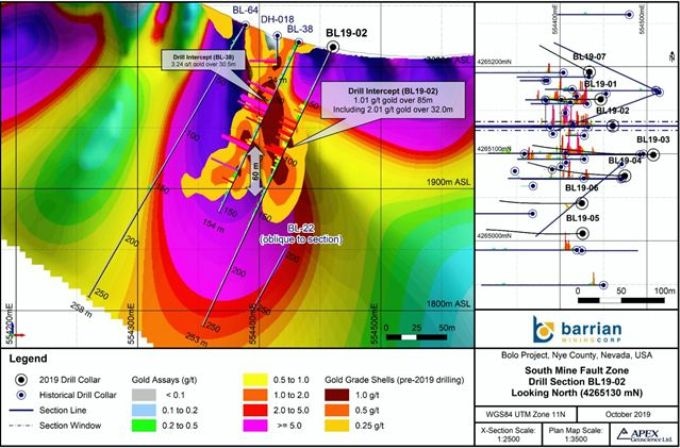Oct 22 2019
Allegiant Gold Ltd. takes pleasure in announcing the results of initial hole drilling at its Bolo Gold Project in Nevada.
 Bolo Gold Project BL19-02 Drill Section (showing resistivity). (Image credit: Allegiant Gold Ltd.)
Bolo Gold Project BL19-02 Drill Section (showing resistivity). (Image credit: Allegiant Gold Ltd.)
The drilling conducted by Barrian Mining Corp. included 10 reverse circulation (RC) drill holes totaling 1838 m. Barrian can gain an initial 50.01% interest in Bolo by carrying out share payments to Allegiant summing up to US$1 million and by achieving US$4 million in exploration costs.
Hole BL19-02 (−65° dip/270 azimuth) intersected 32.0 m of 2.01 g/t gold from 67 m downhole, inside a broader zone of mineralization averaging 1.01 g/t gold more than 85 m from 49 m downhole. Barrian stated that these findings will expand the footprint of gold mineralization about 60 m vertically below the earlier drill section.
The drilling in the South Mine Fault Zone (SMFZ) focused on the down-dip extension of earlier intercepts drilled by Allegiant (when it was a subsidiary of Columbus Gold) in hole BL-38, intersecting 3.24 g/t gold more than 30.5 m from 44 m.
Barrian’s hole BL19-02 intersected Carlin-style gold mineralization about 60 m vertically below BL-38, in visibly modified (silicified and oxidized - limonite ± jarosite/hematite) siltstones, cherty limestones, and jasperoids within footwall Silurian Roberts Mountain Formation and hanging wall Cambrian Windfall Formation dolomite. Mineralization is kept open at a depth below BL19-02.
Anomalous pathfinder element (antimony and arsenic) values from the ALS Global multi-element analysis are in good agreement with gold mineralization in BL19-02 and are quite similar to the concentrations of antimony and arsenic obtained using X-ray fluorescence (XRF) analysis in the field.
More drill findings are expected over the next few weeks. The rest of the drill holes that are not reported intersected considerable mineralized intersections, which could be promising to extend the Uncle Sam Zone and the South Mine Fault Zone. The areas that are drilled are part of a more mineralized trend that extends to more than 1.2 km along strike.
The 2019 Induced Polarization (IP) ground geophysical program was conducted by Barrian. This program shows that mineralized areas could extend to depth and along strike, offering further growth potential across the area of the Bolo Project.
Methodology and QA/QC
The analytical work performed as part of this study was done by ALS Global (ALS), Elko (sample preparation); Reno (gold fire assay), Nevada; and Vancouver (multi-element geochemistry), Canada. ALS is an ISO-IEC 17025:2017 and ISO 9001:2015 certified geoanalytical laboratory. It is not associated with the QP and the Barrian.
RC drill samples underwent crushing, at least 70% passing 2 mm. Then, a 250-g split was pulverized to 85% passing 75 µm. Gold was determined using standard atomic absorption (AA) finish 30-g fire assay (FA) analysis, as well as 48-element ICP-MS geochemistry.
Barrian complies with industry-standard procedures for the work performed on the Bolo Gold-Silver Project, supported by a quality assurance/quality control (QA/QC) program. Blank, duplicate, and standard samples were added into the sample sequence sent for laboratory analysis.
Barrian found no significant QA/QC problems during data review. Barrian is unaware of drilling, sampling, recovery, or other factors that could possibly influence the dependability or accuracy of the data obtained from this study.